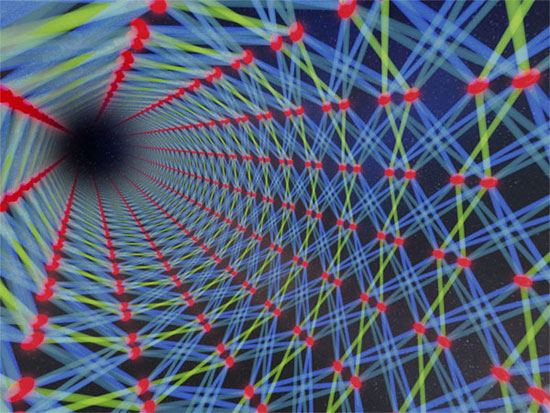The researchers used temporal multiplexing of squeezed light modes, delay loops, and beamsplitter transformations to generate a cylindrical cluster state with a topological structure, as required for universal quantum information processing. The generated state consisted of more than 30,000 entangled light pulses arranged in a 2D cylindrical lattice. The source of 2D cluster states demonstrated by the researchers could be combined with quantum error correction to enable fault-tolerant quantum computation.
 The researchers have produced light beams with special quantum mechanical properties (squeezed states) and woven them together using optical fiber components to form an extremely entangled quantum state with a 2D lattice structure, also called a cluster state. Courtesy of Jonas S. Neergaard-Nielsen.
“As opposed to traditional cluster states, we make use of the temporal degree of freedom to obtain the two-dimensional entangled lattice of 30,000 light pulses,” researcher Mikkel Vilsbøll Larsen said. “The experimental setup is actually surprisingly simple. Most of the effort was in developing the idea of the cluster state generation.”
The researchers have produced light beams with special quantum mechanical properties (squeezed states) and woven them together using optical fiber components to form an extremely entangled quantum state with a 2D lattice structure, also called a cluster state. Courtesy of Jonas S. Neergaard-Nielsen.
“As opposed to traditional cluster states, we make use of the temporal degree of freedom to obtain the two-dimensional entangled lattice of 30,000 light pulses,” researcher Mikkel Vilsbøll Larsen said. “The experimental setup is actually surprisingly simple. Most of the effort was in developing the idea of the cluster state generation.”
In contrast to superconducting technologies for quantum computing, the researchers’ approach could be used to create an optical quantum computer where everything takes place at room temperature. In addition, the long coherence time of the laser light could be maintained as a precisely defined lightwave even over very long distances.
An optical quantum computer would therefore not require costly and advanced refrigeration technology. At the same time, its information-carrying light-based qubits in the laser light would be more durable than the ultracold electronic counterparts used by superconductors.
 An illustration of the temporal evolution of the cluster state generation scheme. Courtesy of Mikkel V. Larsen.
“Through the distribution of the generated cluster state in space and time, an optical quantum computer can also more easily be scaled to contain hundreds of qubits,” professor Ulrik Lund Andersen said. “This makes it a potential candidate for the next generation of larger and more powerful quantum computers.”
An illustration of the temporal evolution of the cluster state generation scheme. Courtesy of Mikkel V. Larsen.
“Through the distribution of the generated cluster state in space and time, an optical quantum computer can also more easily be scaled to contain hundreds of qubits,” professor Ulrik Lund Andersen said. “This makes it a potential candidate for the next generation of larger and more powerful quantum computers.”
The research was published in Science (www.doi.org/10.1126/science.aay4354).

